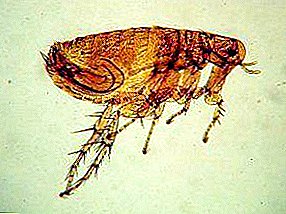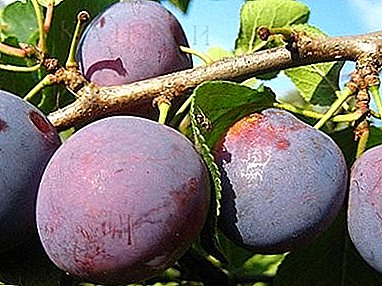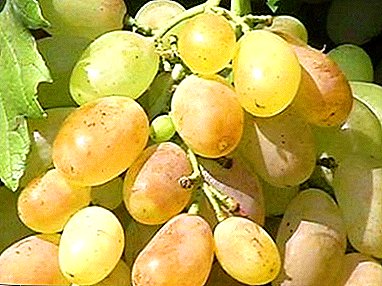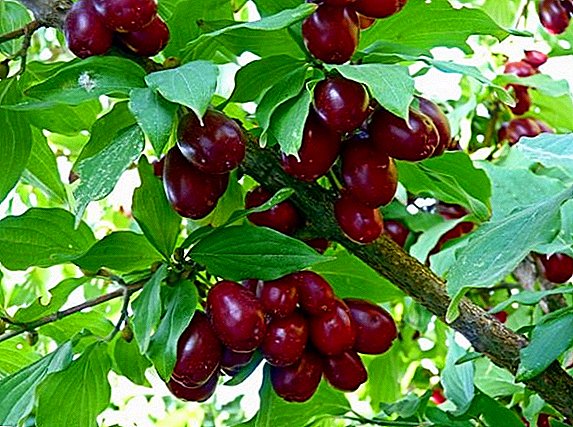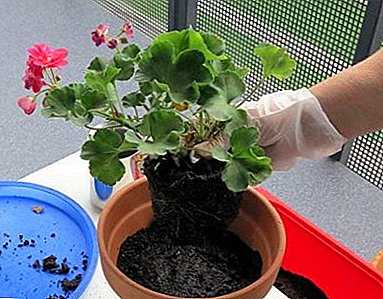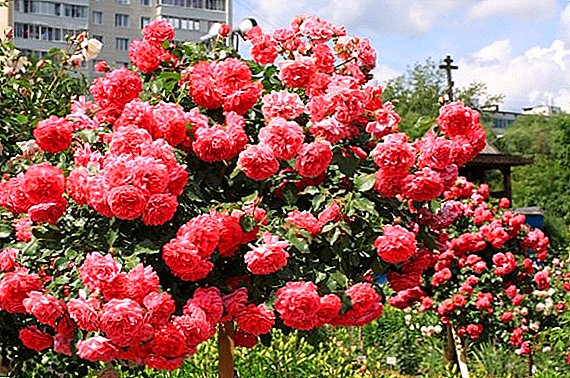 Unusual varieties of ornamental flowering plants today are becoming increasingly popular, despite some difficulties in the care and whimsical. One of these types can be called climbing a rose. This plant is so similar to all of us known rose, but has a huge advantage, as it can be an ideal decor for vertical gardening of any external planes. In this article we will get acquainted with this amazing flower, and also define the basic rules of care and its breeding.
Unusual varieties of ornamental flowering plants today are becoming increasingly popular, despite some difficulties in the care and whimsical. One of these types can be called climbing a rose. This plant is so similar to all of us known rose, but has a huge advantage, as it can be an ideal decor for vertical gardening of any external planes. In this article we will get acquainted with this amazing flower, and also define the basic rules of care and its breeding.
History reference
The homeland of climbing roses is officially considered to be the regions of Southeast Asia, therefore, until the XYIII century Europe, these plant species were not known. In the era of great geographical discoveries, travelers managed to bring a winding rose to Western countries, and it began to actively gain popularity. Over the next two centuries, this flower gradually ceases to be exotic, and it begins to grow almost everywhere. 
Did you know? One of the first climbing roses came to Europe thanks to the Ambassador from the UK, Lord McCartney, in 1793.Climbing rose gained a real popularity boom in the second half of the 20th century, at the same time the variety Rosarium Utersen was bred. The plant was the result of inter-branch selection of the most popular decorative roses. Work on the removal of the flower was carried out for several decades thanks to the efforts of the family Cordes from Germany. I saw the light in 1977.
Botanical description
"Rosterium Utersen" refers to varieties of climers. This is a branched, large-flowered plant, about 3 meters high. The diameter of its flowers is 10-12 cm, they are divided into four uniform segments, so often the view is confused with old terry roses. Petals have a wavy shape, their number in one flower can reach 100 pieces. Flowers can be placed on the plant singly or gather in clusters of 5-6 pieces.
Learn how to properly care for a climbing rose.As they unfold, the petals may fade in the sun, but this does not impair their decorative value, but, on the contrary, helps to emphasize the brightness and beauty of the young. During flowering variety produces a characteristic delicate aroma, in which you can see the light notes of an apple.
Did you know? Today climbing roses top the list of the most popular plants used in vertical gardening. And this is not in vain. According to opinion polls, these roses are considered the most beautiful among all garden plants.The leaves grow on the plant a lot, they have a rich green tint and a shiny surface. Shoots from the variety are often straight, strong, without any difficulty able to withstand any number of flowers. The bushes in the flower are quite wide, in an adult plant they can reach about 1.5 m. The Rosterium Yuthersen blooms in early June, and the peak of flowering is observed in the second half of July.
 Flowering is always abundant, it ends with the first autumn cooling in early September. In addition, the variety is highly resistant to adverse environmental conditions, and therefore remains viable even in the case of strong wind or heavy rain.
Flowering is always abundant, it ends with the first autumn cooling in early September. In addition, the variety is highly resistant to adverse environmental conditions, and therefore remains viable even in the case of strong wind or heavy rain.Application in landscape design
Climbing roses for today are classics of landscape art. As a century ago, this flower is actively used for decorating vertical objects. Most often it is used to create all kinds of flowering arches, capable of pleasing the eye throughout the warm period of time. For this purpose, a special framework is being built, which a few years later the rose is able to entwine completely.
Did you know? Despite the existence of generally accepted terminology, there is no official classification of climbing roses. This is explained by the fact that, according to modern botany, "weaving" is just a feature of the shoots.This flower is also widely used for decorating other garden structures. It can be a lifeless brick wall of a garden house, a gazebo or a veranda. Here the plant is often planted along columns or other structures capable of playing the role of a reliable and durable support. Often the "Rosterium Utersen" can be found along the garden fence.
 A flower in just a couple of years is able to completely cover this architectural form, giving bright colors to a gray fence. It is possible to create a hedge from such a rose, but for this you should make a powerful and durable framework to support the bush.
A flower in just a couple of years is able to completely cover this architectural form, giving bright colors to a gray fence. It is possible to create a hedge from such a rose, but for this you should make a powerful and durable framework to support the bush.Peculiarities of care
Like any other garden species, "Rosary Yuthersen" requires appropriate care and decent conditions for maintenance, only in this case, you will be able to get a healthy, abundantly flowering plant. Next, we will deal with this in more detail and find out how to create the most optimal conditions for the existence of this variety of roses.
In your flower garden you can grow different types of roses - Floribunda, Canadian, tea, English, bush, wrinkled and ground cover.
Landing features
Preparation for planting should be carried out in a few weeks, for this you need to enrich the soil with peat with lime, humus and thoroughly dig everything. In the absence of the above, the soil can be fertilized using wood ash with a calculation of 0.5 kg per 1 square meter. It is also possible to enrich the soil with an aqueous solution of cow dung and clay (1: 2). In 1 bucket of this liquid should be dissolved 3 tablets of phosphorus bacterium. If you have an excessively acidic soil, then this indicator can be improved by adding dolomite flour to the soil.
Important! Before planting a rose, the site should be thoroughly cleaned from debris and weeds, otherwise it may impair the development and growth of the flower.Before planting, the plant should be cut, the length of its roots and shoots should be in the range of 20-30 cm, this will help to intensify the growth of the rose. In order for the slices to heal faster and not be seriously infected by pathogens, they should be covered with garden pitch. The size of the landing pit should be strictly observed; it should be 50x50 cm square and about 70 cm deep.
 For drainage, the bottom is covered with small pebbles, and then a mixture of soil and humus is poured out, while the depth of the fossa should remain within 30 cm. A flower is planted in the prepared well and covered with 10 liters of water. In temperate climates, the best time for the process is the end of September - the first half of October or mid-May.
For drainage, the bottom is covered with small pebbles, and then a mixture of soil and humus is poured out, while the depth of the fossa should remain within 30 cm. A flower is planted in the prepared well and covered with 10 liters of water. In temperate climates, the best time for the process is the end of September - the first half of October or mid-May.Location and lighting
Best of all, roses grow in well-lit areas of the garden, protected from the north wind and draft, but the flower bed should always be perfectly ventilated. The terrain should have a small slope, or be on a hill, this will provide an opportunity to protect the bush from excessive moisture. To avoid depletion of the flower, "Rosterium Hutersen" is not advised to plant closer than 50-60 cm to a wall with a deep foundation or next to other plants at a distance of less than 50 cm.
Important! "Rosa Utersen" It is strongly not recommended to grow in low, dark and excessively wet areas, in the shade of tree crowns, as this depresses the general development of the plant.
Temperature
The variety of roses "Rosarium Yutersen" prefers a subtropical or temperate climate with a sufficient number of warm days, only in this case it will be possible to grow the maximum possible number of flowers. But despite this, the species can grow and develop very well in the 5th zone of frost resistance, which means that the rose is able to withstand frosts around -30 ° С. 
Humidity and watering
As mentioned above, this garden plant does not like excessive moisture, so watering should be gentle. Most experienced florists advise to carry out the procedure no more than 2 times a month. The rate of water for an average adult bush is about 10-12 liters per watering. But at the beginning of the growing season, the rose requires more frequent hydration, the plant is watered every 5-6 days. Dry autumn should take care of moisture charge, for this, if necessary, a well is dug near each bush and supplied with 20 liters of water.
Non-traditional methods of fertilizing with yeast, nettle, and liquid ammonia are increasingly used in households.
Soil and fertilizer
The ideal soil for this plant will be a wet, well-drained soil, with an acid-base reaction in the range of 5.6-7.3. That is why to control this indicator should acquire a special device. The height of the humus sedimentary layer should not be less than 30 cm, and the depth of groundwater should not exceed 1.5 m. As the initial substrate, the well should be filled with a mixture of manure, leaf soil, sand and peat in a ratio of 3: 2: 2: 1 . In the warm season, the soil should be periodically loosened to a depth of about 5-8 cm.  Throughout the growing season, the plant is fed several times:
Throughout the growing season, the plant is fed several times:
- at the beginning of May - with the help of urea solution (30 g of powder per 10 liters of water);
- in the second half of May - complex mineral fertilizer;
- at the beginning of budding - phosphorus-containing fertilizers for flowering plants;
- in the first half of July - with a solution of mullein;
- in early September - phosphorus-potassium fertilizers.
Important! Fertilizers should be applied strictly according to the recommendations of the manufacturer, since excessive fertilizing can adversely affect the growth and flowering of the rose.
Breeding
The plant propagates in two ways - cutting and rooting cuttings. Both of them are equally effective, but they have a completely different procedure and execution scheme. Consider them further in more detail.
Cuttings
Cuttings are cut exclusively from the faded plant. To do this, use the shoots selected from the middle of the bush. The length of the cutting should be no more than 30 cm, while it should be at least 4 healthy buds. The cuttings are planted in a pot with a well-fertilized substrate. With timely loosening and watering in the spring will be able to grow the ideal seedlings for planting in a permanent place. 
Rooting cuttings
Rooting cuttings carried out in early spring. Carefully selected shoots are pressed to the ground and their edges are dropped in, and then they are plentifully covered with earth. Together with the main plant, the layers are also watered and fed. The next spring it can be transplanted. To do this, at a height of 20-30 centimeters from the ground, the shoot is cut and planted using the above method.
Check out such varieties of climbing roses as Pink Intuition, New Dawn, Pierre de Ronsard, Cordes, Abraham Derby, Blue Perfume and Sins Thomas.
Protection against diseases and pests
The main protection measure of this plant is regular treatment of the bush with fungicides throughout the growing season. In the spring, before the appearance of buds, a 0.4% solution of cuprum oxychloride is carried out with a full spraying of the whole hive. During the period of active vegetation, they use more benign substances; this may be an ash-soap solution or analogues.
Did you know? Fungicides have been used by man in their activities for more than one century. More in the narratives of Homer, dating from 1000-800 years BC. Oe., describes the process of fumigating cultivated varieties of plants with sulfur to combat rot, rust and blotches.Spraying the rose with a 1% suspension of colloidal sulfur, which plays a tonic role for the plant organism, will be useful. For additional bacterial protection, it is recommended to add wood ash 2 times per season, in spring and autumn, with the calculation of 100 mg per 1 square meter. In the second half of September, the bush must be treated with a 3% solution of ferrous sulfate.

Pruning
During the period of active vegetation, the species "Rosary Yuthersen" is able to increase the length of its shoots up to 3 meters, so this plant necessarily needs sanitary pruning. Traditionally, the procedure begins in early May, at which time the roses are freed from frosted and weak shoots. The second time the flower is cut in mid-summer to remove its excessive length. Decorative pruning is carried out as necessary in the case of giving the bush the most acceptable form. 
Preparing for the winter
Preparation of roses for winter begins in early September. At this stage, the plant removes all unopened buds, as well as young, old and damaged shoots. The main shoots are shortened by 10-15 cm and firmly connected with each other. Before the onset of frosts, the flower must be bent to the ground as much as possible in several stages so as not to damage it. For this, metal arcs, boards, etc. are used. When a frost occurs, the bush is covered with any covering material, spruce branches or sawdust can also be used. The base of the bush is covered with soil or a mixture of soil and peat.
Important! Between the shoots and the soil should be kept a small space, otherwise the rose will bloom and soak, which will lead to its death.
Difficulty growing
The main difficulties that both beginners and experienced growers can face when growing Rosterium Yuthersen climbing rose are:
- delayed plant development: this process can have several reasons, often it is a consequence of a gross mistake when choosing a place to plant (wrong type of soil, insufficient amount of solar radiation, depressing water regime, etc.);
- pest infestation of the bush: the process begins due to the lack of airing of the bush during excessive waterlogging of the soil;
- decrease in the activity of flowering: the phenomenon is closely dependent on fertilizing, so the plant should be fed during the active growing season;
- substandard planting material: cuttings or cuttings must have a healthy appearance, and on their surface there must be at least 3-4 viable buds.
Rose climbing varieties "Rosary Yuthersen" - this is an elegant and unique plant. The variety is able to cultivate any lifeless space, give it brightness and surprise with aroma. However, in order for your bush to bring only joy for a long time, the rose requires careful care and daily attention during the first months of the growing season. Only in this case can we expect a rich and prolonged flowering of the bush.


